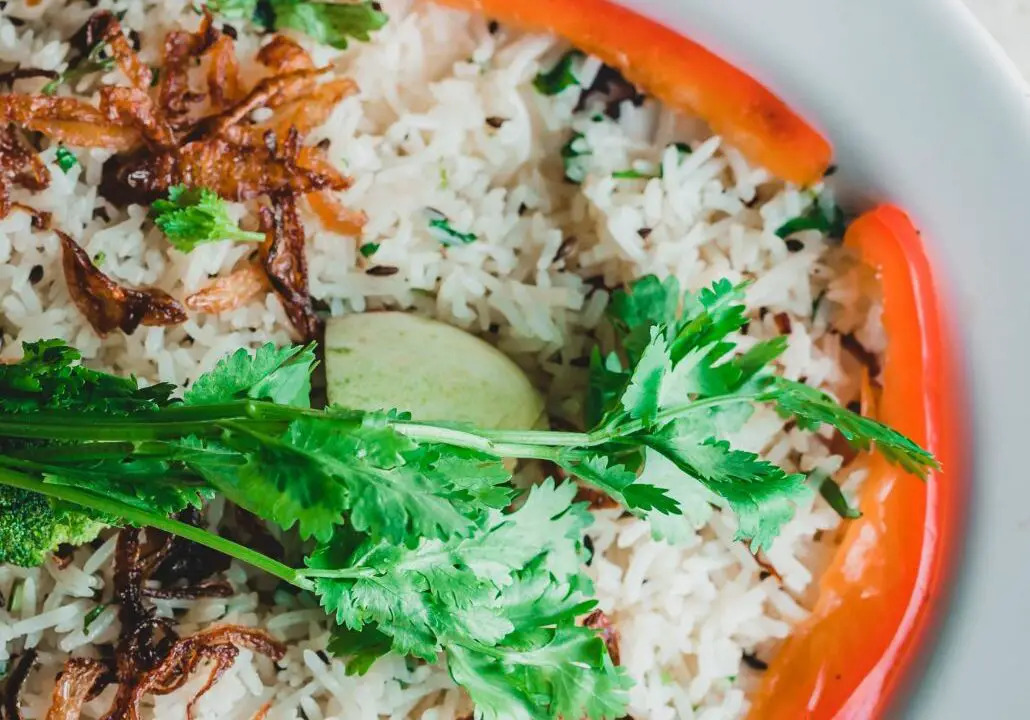
Rice is a staple food that is consumed by millions of people around the world.
It is a versatile grain that can be found in various types, including brown rice, white rice, black rice, red rice, wild rice, and bamboo rice, among others. Rice is an excellent source of carbohydrates, which is why it is considered a great energy booster.
But if you’re trying to lose weight, not all types of rice are created equal. This article looks at the healthiest rice for weight loss.
Table of Contents (click to expand)
Brown Rice
Brown rice is a type of whole-grain rice considered one of the healthiest grains available. Unlike white rice, brown rice has not been stripped of its nutrient-rich bran and germ layers, making it a more nutritious option.
Brown rice is an excellent source of dietary fiber and protein, which helps promote digestive health and weight loss. According to the Harvard School of Public Health, whole grains like brown rice can help lower the risk of heart disease, colorectal cancer, and diabetes.
Brown rice is also rich in B vitamins, magnesium, and phosphorus. It has a low glycemic index, which means it does not cause blood sugar spikes, making it an ideal option for people looking to control their blood sugar levels.
Additionally, brown rice contains soluble and insoluble fiber, which helps keep you full for extended periods, reducing hunger pangs and calorie intake.
When cooking brown rice, it is essential to note that it takes longer than white rice. It must be soaked for a few hours or overnight to reduce cooking time.
Brown rice is slightly nutty, ideal for savory dishes and salads.
Red Rice
Red rice is another type of whole-grain rice that is becoming increasingly popular in recent years due to its high nutritional value.
Red rice gets its distinctive color from anthocyanins, pigments in the outer layer of the grain.
These pigments contain potent plant compounds that have anti-inflammatory properties and may help lower cholesterol levels and the risk of heart disease.
Red rice is an excellent source of dietary fiber, with a slightly higher fiber content than brown rice. It is also a good source of protein, B vitamins, and minerals such as iron and zinc.
Like brown rice, red rice has a low glycemic index, which can help control blood sugar levels and promote weight loss.
When cooking red rice, it is essential to note that it takes longer than white rice. It has a nutty flavor and a slightly chewy texture, making it ideal for salads and stir-fries.
Whole Grain Rice
Whole grain rice is minimally processed, making it a healthier option than starchy rice varieties like white rice.
Whole grain rice is rich in fiber and nutrients, including vitamins B and E, minerals such as magnesium and potassium, and antioxidants.
It is also an excellent source of resistant starch, a carbohydrate not absorbed quickly by the human body. It is an ideal option for people looking to control their blood sugar levels and lose weight.
Whole grain rice has a slightly lower glycemic index than other types of rice, making it a more favorable option for people with diabetes or those looking to control their blood sugar levels. When consuming whole-grain rice, it is essential to note that portion size matters.
While whole-grain rice is a healthy option, it is still a source of carbohydrates, and consuming too much of it can lead to weight gain.
Comparing the Health Benefits of Different Types of Rice
While brown, red, and whole grain rice are all considered healthier options than white rice, they differ slightly in nutritional profiles.
For example, brown rice contains more fiber and micronutrients than white rice, while red rice is higher in antioxidants, has less fiber, and has a lower glycemic index than brown rice.
However, all three types of rice are nutritious ingredients that can be incorporated into a balanced diet for weight loss and overall health.
Choosing rice varieties with nutrients intact and opting for whole grains whenever possible is essential.
Choosing the Best Rice for Your Weight Loss Goals
Several factors must be considered when choosing the best type of rice for weight loss. Firstly, selecting rice varieties that help control blood sugar spikes and grain options such as brown rice, red rice, and whole grain rice is essential.
It is also essential to pay attention to portion sizes and calorie intake, as consuming too much rice can lead to weight gain. Generally, a serving of cooked rice is about 1/2 cup, which provides around 80-120 calories, depending on the type of rice.
Additionally, preparing rice in a healthy way that does not add excess calories is essential. Avoid adding butter, oil, or salt when cooking rice, and instead, season it with herbs, spices, or citrus juice for added flavor.
Cooking Rice for Weight Loss
Healthily cooking rice is essential for promoting weight loss. Here are some tips to keep in mind:
- Opt for brown, red, or whole-grain rice whenever possible.
- Soak rice for a few hours or overnight to reduce cooking time.
- Use a ratio of 1:2 (one cup of rice to two cups of water) when cooking rice on the stovetop.
- Use a rice cooker or instant pot for easy and convenient cooking.
- Avoid adding butter, oil, or salt when cooking rice.
- Season rice with herbs, spices, or citrus juice for added flavor.
Rice-Based Meal Ideas for Weight Loss
Rice can be a staple ingredient in many healthy meals and snacks. Here are some ideas for incorporating rice into your weight-loss diet:
- Brown rice stir-fry with mixed vegetables and lean protein sources such as tofu or chicken.
- Red rice salad with roasted vegetables and a vinaigrette dressing.
- Whole grain rice bowl with black beans, avocado, salsa, and a dollop of Greek yogurt.
- Brown rice sushi rolls with fresh vegetables and seafood.
- Wild rice soup with lean protein sources such as chicken or turkey.
Risks and Considerations When Eating Rice for Weight Loss
While rice is generally considered a healthy food, there are some risks and considerations to consider when consuming rice nutritional and using it for weight loss.
One significant concern is the potential presence of arsenic in rice. Arsenic is a toxic substance that can accumulate in rice during cultivation due to soil contamination and irrigation practices.
Long-term exposure to arsenic can lead to health issues such as cancer and skin lesions. However, the risk of arsenic contamination can be reduced by choosing rice varieties with lower arsenic levels, such as basmati rice from India and Pakistan.
Another consideration is the glycemic index of rice and other foods. While brown, red, and whole grain rice have lower glycemic indexes than white rice, they still contain carbohydrates that can cause blood sugar spikes.
People with diabetes or those looking to control their blood sugar levels should consume rice in moderation and pair it with other nutrient-dense foods to promote blood sugar control.
Conclusion
In conclusion, rice can be a great addition to a healthy and balanced diet for weight loss and overall health.
Brown, red, and whole grain rice are excellent options rich in nutrients and fiber, providing numerous health benefits such as improved digestive health, blood sugar control, and reduced risk of chronic diseases.
However, choosing rice varieties wisely and preparing them healthily is essential to avoid adding excess calories low carb diet. With the right approach, rice can be a powerful tool for those looking to lose weight and improve their overall health.
Frequently Asked Questions
What kind of rice is best for belly fat loss?
When it comes to belly fat loss, brown rice can be a good choice. It’s a whole grain high in fiber, which can help you feel complete for extended periods and thus reduce your overall calorie intake. The high fiber content in brown rice also helps control blood sugar levels and improves digestion. It’s important to note that all types of rice should be consumed in moderation as part of a balanced diet plan, as they are still high in carbohydrates.
What is the healthiest rice?
Various types of rice can be considered healthy, depending on what nutritional aspects you focus on. For overall dietary content, brown rice often comes out on top. It is a whole grain, meaning it retains all parts of the grain — the bran, germ, and endosperm. Foods that are whole grains are high in fiber and dense in nutrients, including B vitamins, iron, magnesium, and selenium.
However, other varieties have their unique benefits. For example, wild rice (technically grass, not rice) is high in protein and fiber. Black rice, also known as forbidden rice, has impressive antioxidant properties.
The healthiest choice for you may depend on your individual dietary needs. For example, if you have issues with blood sugar regulation, basmati rice has a lower glycemic index than other varieties.
Is any rice good for weight loss?
Yes, certain types of rice can benefit weight loss if consumed in moderation and as part of a balanced diet. Brown rice, black rice, and wild rice, in particular, are high in fiber which can help you feel full and satisfied, potentially aiding in weight loss program and control. They also contain a wealth of other beneficial nutrients for overall health.
However, it’s important to note that rice is a high-carbohydrate food, and all types are relatively high in calories. Therefore, you should eat rice in controlled portions, especially if trying to lose weight. Additionally, how you cook your rice and what you eat with it can significantly affect how much rice is and its overall caloric and nutritional content. For example, frying rice or eating it with high-fat sauces or toppings can drastically increase its calorie content.
Remember that losing weight isn’t just about choosing specific foods — it’s about creating a calorie deficit by burning more calories than you consume. Regular physical activity and a balanced, varied diet are key. Always consult with a healthcare provider or a registered dietitian for personalized advice before making any significant changes to your diet.





































